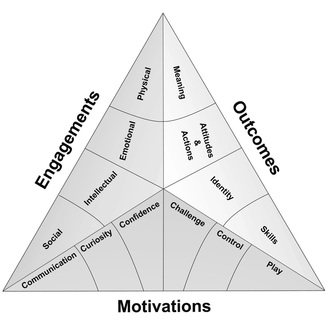Over the next few weeks I’ll be featuring “Designing for the Museum Visitor Experience” by Tiina Roppola (Routledge) [1]. This book is based on Tiina’s PhD research, during which she interviewed over 200 visitors at more than 20 exhibits across a range of Australian museums. Four key elements of visitor experiences emerged from this qualitative, grounded study: Framing, Resonating, Channelling and Broadening. I’ll be presenting summaries of each of these in turn – this week: Framing.
Framing – the assumptions we bring with us
Framing is a semiotic concept used to describe the overarching structures people apply to objects and situations to aid their interpretation. Frames are essentially a collection of categories, criteria and expectations we use as part of the meaning-making process.
People have frames for museums and for exhibits, which are informed by their past experiences. These “frame” the encounters they will have as visitors. Not everyone brings the same gamut of frames to their museum visit, although there are some common patterns. Accordingly, Roppola identified a number of frames that people tend have about museums and exhibits:
Museum Frames:
- The “displayer of artefacts” frame: for visitors holding this frame, the defining characteristic of a museum is the display of material objects. Other types of displays and interpretive media may be dismissed or ignored as not being “real things”.
- The “learning” frame: an expectation that museums are primarily a site for learning, and that the museum will be an authoritative source of facts and knowledge. People may visit museums to enact their identity of being learning-oriented people.
- The “enjoyment” frame: held by visitors who find museums pleasurable places to be. This could be through interaction with certain kinds of interpretive content or simply through appreciation of the general ambiance. “Enjoyment” can mean “fun”, but not necessarily so: people can also talk about “enjoying” more solemn experiences in a museum context. [2]
- The “pilgrimage” frame: applies to visits to see specific personally or culturally significant objects or sites. People queue to see the Mona Lisa so they can say that they’ve seen it. In an Australian context, many people visit Melbourne Museum specifically to see the racehorse Phar Lap. War Memorials are also a site of cultural pilgrimage.
Visitors may also hold different frames for different types of museums. So what is deemed appropriate (ie.,frame-congrent) in an art gallery might be considered baffling or even offensive in the context of a natural or cultural history museum. In the art gallery, there is an expectation that exhibits may be metaphorical, but transplant the same item to a museum and it may be taken literally and not recognised as art at all.
Exhibit Frames:
- “Materially distinct” – an expectation that exhibits will be different from things you can see elsewhere (e.g. in a book, on the web, or on TV).
- “Explanatory” – exhibits should provide sufficient information and adequate labelling. Insufficient information can leave visitors frustrated and unsatisfied.
- “Temporal” – exhibits should be regularly updated so that there is always something new to see.
In many cases, these frames were only specifically mentioned when they had been violated in some way. When visitors encountered exhibits that were contrary to their frames of what an exhibit is “supposed” to be, the response was often negative. This is typical of frames more generally – we aren’t consciously aware of them unless we encounter something which is incongruent with them.
Reframing
Our frames are not static and they will evolve and change as we encounter new situations. This reframing can be both positive and negative. For instance, modern museum buildings that are open and bathed in natural light can represent a positive reframing for people who see the traditional museum as “dark and dusty”. But conversely, some visitors may find discordance in the juxtaposition of old objects and modern architecture.
Satisfying encounters with different types of interpretive media can lead to reframing – for instance moving from a more passive “displayer of artefacts” museum frame to one that incorporates a broader mix of media including more tactile and interactive elements.
Next week – Resonating
[1] I first met Tiina at the 2010 Museums Australia conference, where I tracked her down and quizzed her about her research (it was while I was developing my own PhD research proposal). We’ve since become friends and colleagues and her work has been a big influence on mine. As I go through my own data I’m seeing many parallels with her findings, although I remain in awe at the depth and sophistication of what she produced for her PhD. It’s an exemplary piece of qualitative research and I can’t really do it justice here. I highly recommend the book, which is richly illustrated with quotes from the visitor interviews.
[2] Roppola draws the distinction between “enjoyment” (a word that spontaneously emerged in her interviews) and “entertainment” (which was seldom mentioned). This is an important semantic difference to my mind, and one I’ll come back to in a future post.







